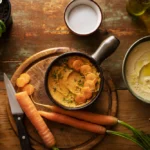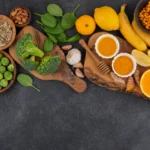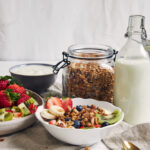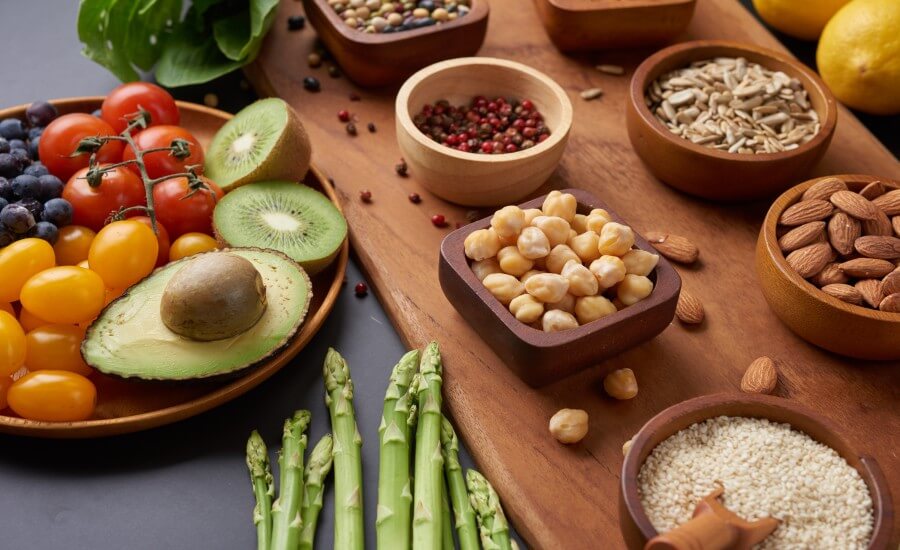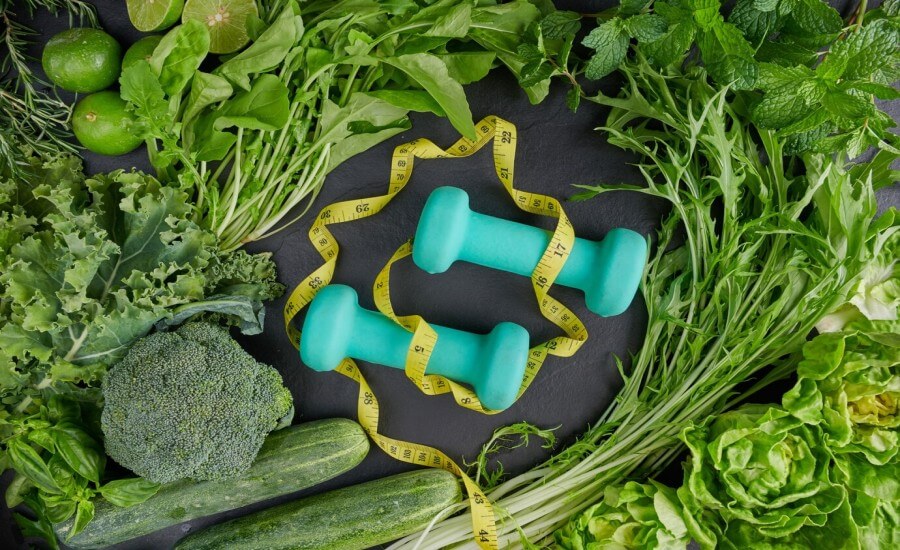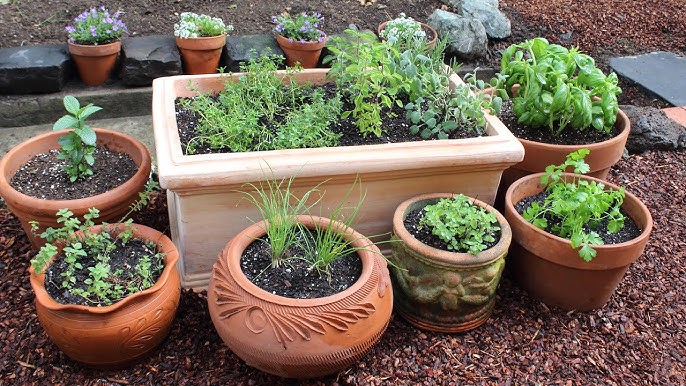Festive gatherings, whether for holidays like Thanksgiving, Diwali, Christmas, or simply large family get-togethers, often revolve around a shared meal – a feast symbolizing abundance, gratitude, and togetherness. Traditionally, many such feasts feature meat as the centerpiece. However, embracing a vegan lifestyle opens the door to creating equally lavish, satisfying, and celebratory vegan festive feasts. This guide explores how to craft a memorable plant-based vegan holiday celebration, using the North American Thanksgiving meal as a detailed example but offering principles and ideas adaptable to any festive occasion, anywhere. We’ll examine the nutritional aspects of abundant plant-based eating, the ethical joy of compassionate celebrations, the environmental benefits, and the practical recipes and planning tips needed to host with confidence and flavour, drawing inspiration applicable even here in Jaipur.
Vegan Feasts for Festive Occasions
LENS 1: Nutritional Analysis (Nourishing Abundance)

While festive meals are often indulgent, a vegan feast can be designed to be both celebratory and surprisingly nourishing.
- Balanced Spread: A well-planned vegan feast offers a fantastic opportunity to showcase nutritional diversity:
- Centerpiece Power: Instead of turkey, focus on nutrient-dense options like a hearty Lentil Loaf (protein, fiber, iron), Mushroom Wellington wrapped in pastry, colourful Stuffed Squash or Pumpkin (Kaddu) filled with grains/nuts/veg (Vitamins A & C, fiber), or even elaborate vegetable terrines.
- Vibrant Sides: This is where plant-based feasts truly shine. Think roasted root vegetables (carrots/gajar, potatoes/aloo, sweet potatoes – complex carbs, vitamins), green bean dishes (made creamy with cashews instead of dairy), Brussels sprouts, diverse salads, whole-grain stuffing/dressing, naturally sweet cranberry sauce (antioxidants), and mashed potatoes (using plant milk/butter).
- Healthy Fats: Incorporate healthy fats for richness and satiety through nut-based gravies (cashew cream), olive oil for roasting vegetables, nuts and seeds in stuffings or toppings, and avocado in salads.
- Complex Carbs: Emphasize whole grains in stuffings or side dishes (like a vegetable pulao), sweet potatoes, squash, and root vegetables for sustained energy.
- Nutritional Advantages: Compared to traditional meat-heavy feasts, a well-planned vegan spread is typically much higher in fiber, antioxidants, vitamins (like C, K, folate, beta-carotene), and minerals, while containing zero dietary cholesterol and often less saturated fat.
- Mindful Feasting: Abundance doesn’t have to mean overeating. Encourage mindful enjoyment, savoring flavours, and listening to satiety cues. The high fiber content of plant-based dishes often helps with feeling full sooner. Remember B12 supplementation as part of an ongoing vegan diet. How can you design your festive menu to include a wide rainbow of colourful vegetables, ensuring diverse nutrient intake?
Nutritional Deep Dive: Crafting a Balanced Vegan Feast Plate
Aim for variety and balance, even amidst abundance:
- Protein Anchor: A slice of lentil loaf, stuffed squash with quinoa/nuts, or a generous serving of bean salad/tofu dish.
- Complex Carbs: A portion of whole-grain stuffing, roasted root vegetables, or sweet potato casserole.
- Vegetable Variety (Fill Half the Plate!): Load up on roasted Brussels sprouts, green bean casserole, glazed carrots, fresh salad, cranberry sauce.
- Healthy Fats/Flavor: Gravy, a sprinkle of nuts/seeds, dressing on the salad.
- Mindful Portion: Start with smaller servings of each dish to sample everything without overfilling initially.
Voice of Experience (Registered Dietitian specializing in Plant-Based Nutrition): “A vegan festive feast can be incredibly nutritious! By focusing on whole food ingredients – colourful vegetables, legumes, whole grains, nuts, seeds – you create a meal packed with fiber, vitamins, minerals, and antioxidants. Using techniques like roasting and incorporating healthy fats from nuts or avocados for creaminess allows for indulgence without excessive saturated fat or cholesterol.” – Dr. Anjali Sharma, RDN
LENS 2: Ethical Framework (Compassionate Celebrations)

Hosting or participating in a vegan festive feast infuses celebrations with deep ethical meaning.
- Celebrating Without Sacrifice: The core ethic is celebrating gratitude, harvest, family, and togetherness without involving the suffering or death of animals. It reframes traditional narratives (like Thanksgiving’s turkey focus) to center on the abundance of the plant kingdom.
- Ethical Sourcing for Special Occasions: Make the feast even more meaningful by sourcing ingredients consciously. Use local, seasonal produce (supporting Jaipur farmers for vegetables like pumpkin, potatoes, carrots in cooler festive seasons), Fair Trade certified sugar, chocolate (for desserts), coffee, vanilla, and spices. Choose ethically produced plant-based staples.
- Inclusivity & Hospitality: Hosting a vegan feast (or bringing significant vegan contributions to a mixed gathering) demonstrates inclusivity and thoughtful hospitality, ensuring everyone can partake fully and joyfully, regardless of dietary choices. It models compassionate eating positively.
- Minimizing Festive Waste: Large gatherings can generate significant food waste. Plan portions carefully, get creative with leftovers (soups, stews, pot pies, sandwiches), encourage guests to take food home, and compost scraps. This aligns the celebration with the ethical principle of resourcefulness.
- Joy of Shared Compassion: There is a unique joy in sharing a delicious, abundant meal prepared with care and compassion, knowing that the celebration aligns fully with one’s values. How can consciously choosing ethically sourced ingredients elevate the meaning of your festive meal?
Hidden Benefits: Inspiring New Traditions
Sharing an impressive and satisfying vegan feast can inspire non-vegan friends and family, showing them how delicious and abundant compassionate celebrations can be, potentially sparking curiosity and creating new, kinder traditions within families or communities.
Voice of Experience (Vegan Lifestyle Advocate & Host): “Hosting vegan Diwali or Christmas feasts is about showing love through food that aligns with our values. It’s proving that tradition and compassion can coexist beautifully. When guests enjoy a rich vegan korma or a stunning plant-based centerpiece, it opens hearts and minds far more effectively than any lecture.” – Priya Kapoor, “Compassionate Kitchen” Blog
Critical Reassessment: Navigating Tradition & Effort
Introducing vegan options into deeply rooted family or cultural traditions requires sensitivity and respect. Focus on adding delicious alternatives rather than demanding elimination of others’ choices initially. Acknowledge that preparing an elaborate vegan feast can require significant planning, effort, and potentially cost for specialty items, which may not be feasible for everyone.
LENS 3: Ingredient Science & Environment (Sustainable Feasting)

The science behind vegan festive cooking allows for decadent results with a significantly lighter environmental footprint.
- The Science of Vegan Feasting:
- Binding Loaves/Roasts: Using binders like flax eggs, breadcrumbs, cooked grains (rice, oats), or mashed vegetables (potato) helps hold savory centerpieces together. Gluten development in wheat-based options (like Wellingtons) provides structure.
- Flaky Pastry: Achieving flaky vegan pastry (for Wellingtons, pies) involves using cold vegan butter alternatives or solid coconut oil, cut into flour, creating layers separated by fat that produce steam and lift during baking.
- Creamy Textures: Emulsification techniques using blended cashews, silken tofu, white beans, or cooked vegetables (cauliflower, potato) create rich gravies, creamy casseroles, and smooth pie fillings without dairy.
- Flavour Development: Slow roasting vegetables, caramelizing onions, using umami-rich ingredients (mushrooms, nutritional yeast, tomato paste), and layering herbs and spices builds deep, complex flavours.
- Environmental Impact: A plant-based feast is vastly more sustainable than a traditional meat-centric one:
- Lower Footprint Centerpiece: The resources (land, water, feed) and greenhouse gas emissions required to produce a lentil loaf, stuffed squash, or mushroom Wellington are drastically lower than those for raising a turkey or roast beef.
- Seasonal & Local Sides: Emphasizing seasonal vegetables (root vegetables, squash, greens common in Indian winters, aligning with North American harvest season) reduces food miles and supports sustainable regional agriculture.
- Reduced Dairy/Egg Impact: Replacing dairy milk, cream, butter, and eggs with plant-based alternatives significantly lowers the associated environmental footprint (methane emissions, land/water use).
- Waste Reduction: Planning carefully and using leftovers minimizes the significant environmental impact of food waste generated from large meals. How does choosing a stuffed squash or lentil loaf as your centerpiece contribute to a more sustainable celebration?
Market Transformation Map Suggestion: Data showing the increasing availability and sales growth of commercial vegan holiday roasts, vegan puff pastry, and plant-based creams during festive seasons globally and potentially in larger Indian cities.
Voice of Experience (Environmental Food Policy Expert): “Holiday meals often have a large environmental footprint due to high meat consumption. Shifting towards plant-based festive feasts centered around legumes, grains, and seasonal vegetables offers one of the most impactful ways for individuals and families to reduce their environmental impact during celebratory periods, significantly cutting down on emissions, land use, and water consumption.” – Dr. Arjun Singh, Sustainable Food Trust
LENS 4: Everyday Practitioner’s Experience (Recipes, Planning & Hosting)
Hosting a delicious vegan festive feast requires planning and some go-to recipes. Here are ideas, using Thanksgiving as a template but easily adaptable:
The Centerpiece (Beyond Turkey):
- Mushroom Wellington: Sautéed mushrooms and often lentils/walnuts wrapped in vegan puff pastry (check store-bought ingredients or make your own). Impressive!
- Stuffed Squash/Pumpkin (Kaddu): Roasted acorn, butternut squash, or small pumpkins filled with a savory mixture of grains (quinoa, rice, millet), nuts, seeds, dried fruit, herbs, and vegetables. Visually stunning and seasonal.
- Hearty Lentil Loaf: A savory baked loaf made from lentils, vegetables (onion, carrot, celery), grains/breadcrumbs, herbs, and seasonings, often glazed. Satisfying and sliceable.
- Vegan Shepherd’s Pie: A comforting casserole of rich lentil and vegetable stew topped with creamy mashed potatoes (use plant milk/butter).
- Indian Inspired Centerpiece: Consider an elaborate Vegetable Biryani, stuffed large vegetables (like peppers or tomatoes), or a rich, centerpiece-worthy curry like a Vegan Shahi ‘Paneer’ (using tofu/cashews).
Sensational Sides (Veganized Classics & Indian Options):
- Mashed Potatoes: Use plant milk (unsweetened oat or soy work well), vegan butter, roasted garlic, salt, pepper.
- Mushroom Gravy: Sauté mushrooms, onions, garlic. Make a roux with plant butter/oil and flour, whisk in vegetable broth, add nutritional yeast/soy sauce for umami. Simmer until thickened.
- Green Bean Casserole: Steam green beans. Make a creamy sauce with blended cashews or white beans, mushrooms, broth, nutritional yeast. Top with homemade or store-bought crispy fried onions (check ingredients).
- Stuffing/Dressing: Use vegetable broth instead of chicken broth. Sauté onions, celery, herbs (sage, thyme). Add bread cubes (whole grain preferred), nuts/seeds, dried cranberries/raisins, apples/mushrooms. Bake until golden.
- Cranberry Sauce: Easy to make homemade: simmer fresh or frozen cranberries with water/orange juice and sweetener (sugar/maple syrup) until berries pop and sauce thickens. Much better than canned!
- Roasted Vegetables: Toss winter root vegetables (carrots, potatoes, parsnips, sweet potatoes available seasonally in India too) or Brussels sprouts with oil, herbs, salt, pepper. Roast until tender and caramelized.
- Indian Sides: Vegetable Pulao, Jeera Rice, various Sabzis (e.g., Aloo Gobi, Matar Mushroom), Vegan Raita (using plant yogurt, cucumber, spices), fresh Chutneys.
Divine Desserts:
- Vegan Pumpkin Pie: Use pumpkin puree (kaddu), plant milk or cream (cashew/coconut), spices (cinnamon, ginger, nutmeg, cloves), sweetener, and cornstarch/agar in a vegan pie crust.
- Apple Crumble/Pie: Use a filling of spiced apples topped with a crumble made from oats, flour, vegan butter, sugar, cinnamon. Serve warm.
- Pecan Pie: Adaptations use corn syrup/maple syrup, vegan butter, flax eggs, and pecans in a vegan crust.
- Indian Desserts: Vegan Kheer (rice pudding with plant milk, cardamom, nuts), Vegan Gajar ka Halwa (using plant milk/butter, carrots, sugar/jaggery, nuts).
Planning & Hosting Tips:
- Plan Ahead: Finalize your menu weeks in advance. Create a shopping list. Make a detailed prep timeline (what can be made days ahead, day before, day of?).
- Make Ahead: Many components can be prepped: chop vegetables, make cranberry sauce, bake pies/desserts, assemble casseroles (bake day of), make gravy base.
- Delegate/Potluck: Don’t be afraid to ask guests to bring a dish (provide recipe or clear instructions if needed) to share the load.
- Set the Atmosphere: Create a warm, welcoming environment with decorations, music, and comfortable seating.
- Communicate: If hosting non-vegans, communicate gently that the meal will be fully vegan. Focus on the delicious food you are serving. If attending as a vegan, offer to bring a substantial dish to share.
What vegan centerpiece dish sounds most exciting to make for your next celebration?
Daily Impact: The Festive Leftover Plan
Anticipate leftovers! Plan creative ways to use them: stuffing muffins, shepherd’s pie with leftover gravy/veg, cranberry sauce on toast, leftover roast veg in salads or wraps. This minimizes waste and extends the enjoyment.
Voice of Experience (Seasoned Vegan Host): “Hosting a big vegan feast is all about planning! I make my desserts and cranberry sauce a day or two ahead. Sides like stuffing or casseroles can be assembled the day before. On the day, it’s mainly about the centerpiece, reheating sides, and making gravy. Delegating salads or drinks also helps immensely!” – Sunita Verma, Home Entertainer
Alternative Approaches: Simple & Intimate Feasts
A festive meal doesn’t have to be overly elaborate. Focus on 2-3 really well-made main dishes (e.g., a great lentil loaf, amazing mashed potatoes/gravy, roasted vegetables) and a simple dessert for a smaller, less stressful but equally special gathering.
PERSPECTIVE INTERSECTION MATRIX
- Nutrition & Planning (Lens 1 & 4): Thoughtful menu planning (Lens 4) ensures the feast offers nutritional balance (Lens 1) amidst the indulgence. Make-ahead strategies (Lens 4) help manage time without sacrificing quality (Lens 1).
- Ethics & Inclusivity (Lens 2 & 4): Ethical hosting (Lens 2) involves practical steps like clear communication, offering diverse options, and managing waste effectively during the feast (Lens 4).
- Environment & Seasonality (Lens 3 & 4): Choosing seasonal ingredients (Lens 3) is a practical decision made during menu planning and shopping (Lens 4), reducing the feast’s footprint.
- Science & Centerpieces (Lens 3 & 4): Understanding binding and pastry science (Lens 3) is key to successfully creating impressive vegan centerpieces like Wellingtons or loaves (Lens 4).
- Tradition & Adaptation (All Lenses): Creating a vegan feast often involves adapting traditional recipes (Lens 4), requiring nutritional awareness (Lens 1), ethical motivation (Lens 2), and ingredient knowledge (Lens 3).
MISCONCEPTION ANALYSIS
| Misconception | Reality |
| A vegan feast (like Thanksgiving) feels incomplete or sad without a turkey. | The focus shifts! A stunning plant-based centerpiece (stuffed squash, Wellington, loaf) surrounded by abundant, flavourful, colourful side dishes creates a feeling of bounty and celebration that is deeply satisfying and visually impressive. |
| Vegan festive food can’t be as rich, flavourful, or satisfying as traditional. | Plant-based ingredients masterfully create richness (cashew cream, coconut milk, vegan butter, nuts), deep flavours (roasted veg, mushrooms, umami boosters, spices), and hearty textures (lentils, grains, root veg), leading to incredibly satisfying meals. |
| Preparing an entire vegan feast is overwhelmingly difficult and expensive. | Planning, make-ahead strategies, focusing on simpler homemade dishes using staples (vegetables, legumes, grains), and potluck contributions make it manageable. Many core ingredients are budget-friendly compared to large meat roasts. |
| Guests (especially non-vegans) won’t enjoy a fully vegan celebration meal. | Delicious food is delicious food! Well-executed, flavourful vegan dishes often surprise and delight guests, regardless of their usual diet. Focus on abundance, flavour, and familiar comforting elements (gravy, potatoes, pie). |
| You can’t recreate classic holiday flavours without meat, butter, or cream. | Many classic flavours come from herbs (sage, thyme, rosemary), spices (cinnamon, nutmeg), vegetables (onions, celery, carrots), and cooking methods (roasting). These can all be achieved veganically, often with healthier fats and ingredients. |
KEY TURNING POINTS
- Growth of Veganism: Simply more people seeking plant-based options for all occasions, including major holidays.
- Culinary Innovation: Chefs and home cooks developing sophisticated techniques and recipes for vegan roasts, pastries, creams, and gravies.
- Resource Sharing (Online): Proliferation of blogs, websites, and social media dedicated to vegan holiday recipes and hosting tips.
- Improved Vegan Products: Better-tasting and performing vegan butters, creams, puff pastry, and even commercial holiday roasts becoming available.
- Shift in Focus: Growing cultural appreciation for vegetable-forward cooking and celebrating seasonal plant bounty, moving beyond meat as the automatic centerpiece.
SYNTHESIS & RECOMMENDATIONS
Creating a vegan festive feast, whether for Thanksgiving, Diwali, or any cherished gathering, is a beautiful way to celebrate abundance, connection, and compassion. Far from being a sacrifice, it’s an opportunity for culinary creativity, showcasing the incredible flavours and textures possible with plant-based ingredients. With thoughtful planning, delicious recipes focusing on seasonal bounty (wherever you are, including Rajasthan!), and techniques for creating satisfying centerpieces and sides, your vegan celebration can be every bit as indulgent, memorable, and heartwarming as any traditional feast – perhaps even more so, thanks to the ethical peace of mind it brings.
Recommendations for a Joyful Vegan Feast:
- Plan Extensively: Create your menu, shopping list, and prep schedule well in advance.
- Choose a Star Centerpiece: Select a satisfying vegan main dish (stuffed squash, lentil loaf, Wellington) that feels special.
- Focus on Abundant Sides: Offer a wide variety of colourful, flavourful vegetable dishes, grains, and salads – this is where vegan feasts truly shine.
- Master Vegan Staples: Learn to make a good vegan gravy, creamy mashed potatoes, and perhaps one reliable vegan dessert.
- Make Ahead: Prepare as much as possible in the days leading up to the feast to reduce stress on the day.
- Embrace Seasonality & Locality: Use fresh, seasonal produce available in your region for the best flavour and sustainability.
- Communicate & Collaborate: If hosting mixed company, communicate the menu clearly. Don’t hesitate to accept offers of help or suggest guests bring a vegan dish (potluck style).
- Enjoy the Process & the People: Remember the goal is celebration and connection. Relax, enjoy the cooking, and savor the time with loved ones around a compassionate table.
FURTHER AREAS OF EXPLORATION
- Vegan Centerpiece Showstoppers (Recipes & Techniques)
- The Ultimate Guide to Vegan Gravies
- Veganizing Classic Holiday Side Dishes (Stuffing, Casseroles, etc.)
- Easy & Elegant Vegan Holiday Desserts
- How to Host an Inclusive Feast for Vegans and Omnivores
- Adapting Traditional Indian Festival Sweets & Savouries to be Vegan
- Tips for Reducing Food Waste After a Large Feast

